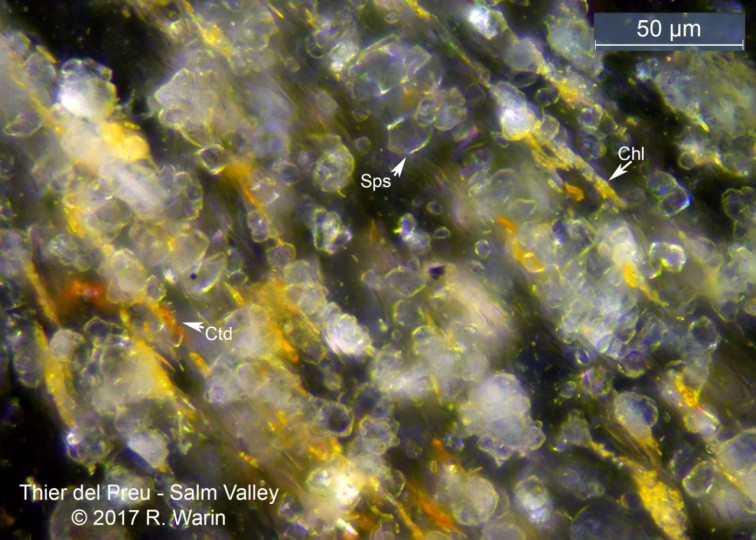|
COTICULE COMPOSITION
The coticule is a finely grained
metasedimentary rock of yellow color that has undergone a metamorphism
that caused its schistosity. It is mainly composed of quartz,
spessartine (manganese garnet) and micas. It appears as interstratified
layers in hematite-rich purple slates of the lower Ordovician (= about
477 Ma). My photo with an optical microscope
is a first, at least in the image processing that highlights the three
essential components (size 5 to 20 microns or 0.005 mm to 0.020 mm)
embedded in a microcrystalline matrix of micas and quartz, appearing in
black on the photo (polarized light). Generally the photos are not
contrasted. As a result, the photos are then taken under the electron
microscope. The color of the matrix is of course
yellowish. But I was able to blacken it because it is microcrystalline. The presence of manganese garnets,
that is to say spessartine, is inherent to the term
"coticule". If the presence of spessartine decreases or is
absent, whereas quartz and iron oxides, including hematite, become more
important and the composition of the rock slides towards that of the
pseudocoticula. This gradual transition favors a variable sedimentary
origin in cycles. It is random. The variability of the various types of
"good" coticules (Vintage!) also supports this thesis. These
compositional variations change the color of the rock. Thus, the first
degradation results from an increase of quartz at the expense of
spessartine. The color then takes on greenish hues and loses its
abrasive properties. The schistosity printed the texture
of the coticule, thus creating alignments of the composites. The
phenomenon is clearly visible on chlorites. The small garnets (cubic system) are
colorless in the photo and also align in strings. Garnet crystals are
characterized by a strong relief (additional analytical criterion). This
means that the edges of the crystal are well highlighted, in relief. The garnet crystals are most often
dodecahedra, trapezohedra, etc., all of globular appearance. Chlorites are phyllosilicates,
laminated texture. Chloritoids also have a strong
relief. Accompanied by garnets, they are witnesses to the weak
metamorphism that has undergone the coticule. The matrix appears in black under
these conditions of taking the photo. This contrast highlights the texture
of the rock and its components. Interpretation
of the photo:
Legend of notes: Sps = spessartine,
the manganese garnet. Chl = Chlorite.Ctd = chloritoid. EFFICIENCY The coticule is one of the most
successful whetstones when you want to get a great finish. We have
obviously imagined ersatz with garnets of the same size incorporated
into an artificial matrix, but they have never worked. But the unique
qualities of the coticule is that it is not subject to jams, waste
eliminating spontaneously. This is due to the texture of the stone.
Garnets and other silicates such as chlorites are included in a
micaceous matrix of muscovite. In addition, the general texture derived
from the schistosity has created strings of crystals aligned with
spessartine. The debris is eliminated in minute parallel areas of weaker
cohesion (hardness ~ 3.5). So coticule rock, soft to the touch, wears
easily while its active components (crystals of spessartine) have a
hardness of 7 on the scale of Mohs
Roger Warin. |
